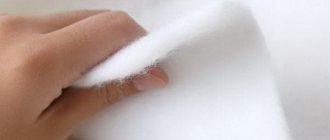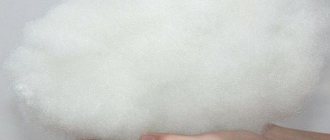Features of the structure of linoleum
Before moving on to the wear resistance classes of linoleum, let's consider the structure of the material. Depending on the type and cost, linoleum consists of many layers, but when choosing, it is especially important to pay attention to the following ones:
Base
This is the first or bottom layer of flooring and is usually made from a synthetic material or cork. It makes linoleum softer, serves as a shock absorber and creates additional sound insulation.
Moisture-proof layer
If you buy waterproof linoleum, this layer will be present. It absorbs moisture and does not swell, so the integrity of the floor is not compromised even when exposed to water.
Decorative layer
Determines the appearance of the new floor. While the other layers are important to the function and longevity of the product, it is the decorative one that gets the buyer excited as there are so many options, colors, textures and colors available now.
Protective layer
How long linoleum will last depends on its quality. The reliability of the protective coating layer can be determined by the wear resistance class.
The wear resistance of linoleum depends on its protective layer
History of origin
It is believed that the impetus for the invention of linoleum was ordinary oilcloth, which has been used in everyday life since 1627. At that time, this material was a fabric impregnated with wax, resin and linseed oil. This composition ensured high strength and water resistance of the material.
The first samples of linoleum appeared in 1863 thanks to the works of the English industrialist Frederick Walton. Translated into Russian, linoleum means “oiled canvas”, from linum - linen, fabric, oleum - oil.
According to Walton's technology, burlap and jute fabric were used as a base for the manufacture of linoleum, onto which oxidized linseed oil (linoxene) was applied. The result was a dense, abrasion-resistant, but brittle fabric. During the research, it turned out that the new material does not ignite easily and is so strong that it cannot be pressed through either by a heel or a furniture leg.
Three years after Frederick patented his discovery, mass production of the new finishing material began. The rapid pace of introduction of new technology in European countries was explained by the demand for flooring in construction and the ease of organizing production.
What does linoleum class mean and how to determine it?
The most important thing to understand in this matter: classes do not refer to floor coverings, but to the rooms where they will be installed. To indicate for which class of premises a particular coating is suitable, manufacturers supply their products with special markings. The packaging contains two-digit digital indexes - 21, 22, 33, 41, etc. The first digit indicates the type of room:
- “2” - living space,
- "3" - public,
- "4" - production.
The second is the degree of intensity of use.
- "1" - low,
- “2” - moderate,
- "3" - high,
- “4” - no restrictions on intensity.
Depending on these digital indices, household, semi-commercial and industrial linoleum are distinguished.
Linoleum is used in residential and commercial premises
What do grades 21, 22 and 23 mean: household linoleum
This linoleum is used in rooms with low load intensity. The stores offer a wide range of household linoleum - from high-end products to budget options.
The so-called improved household linoleum deserves special attention. It uses a more durable protective layer, making it suitable for placement in rooms up to class 32. And when used in residential premises of 21-23 classes, it will have a longer service life.
What does class 31, 32, 33 and 34 mean: semi-commercial linoleum
This coating is used in public and office premises and is characterized by increased density due to the special composition of the raw materials used.
For semi-commercial linoleum used in preschool institutions, special safe and environmentally friendly coatings with an appropriate design are used.
What does class 41, 42 and 43 mean: industrial linoleum
As the name suggests, this linoleum is used in industrial, manufacturing and commercial enterprises.
Its main features are the high density of the material, the thickness of the protective layer and a wide selection of products for the specific needs of industrial premises.
Choose linoleum based on the amount of traffic in the room. Where you walk more often requires a more durable coating
Note! It is quite difficult to visually distinguish household linoleum from commercial and industrial ones. Therefore, before purchasing, carefully study the coating label or consult with the seller to find out for sure whether it is suitable for your purposes.
Coverage groups
Another classification of linoleum is by structure. It also affects its wear resistance class. Linoleum is distinguished by its structure:
- Homogeneous is a single piece of fabric, without layers or substrates. During its production, it is possible to achieve uniformity throughout the entire thickness - the pattern is applied in bulk. This guarantees the preservation of appearance for many years of use. This wear-resistant linoleum is an excellent solution for public places with high traffic.
Note! Due to the special production technology of homogeneous linoleum, it is not possible to create a designer image on it. It turns out plain or with marble imitation. But the class of application of linoleum of this type is the highest.
- Heterogeneous. This type can be called universal, because it is used everywhere. Due to the multilayer structure (from 4 to 6 layers), the coating is given the required technical characteristics. At the same time, the visual component does not suffer - the range of colors, textures and design ideas is simply huge. This type of coating has options with insulation, when a base made of foamed polyvinyl chloride or jute or felt is glued to the back part. In addition to increased thermal insulation, such linoleum also provides good sound insulation.
Recommendations for the use of linoleum of different classes
| Linoleum class | Wear resistance level | Description | Application example |
| Household linoleum | |||
| 21 | Moderate | Low or intermittent use areas | Bedroom, dining room |
| 22 | Average | Medium Use Areas | Children's room, living room, hallway |
| 23 | High | High Use Areas | Kitchen, living room, corridor, office, hallway |
| Semi-commercial linoleum | |||
| 31 | Moderate | Low or intermittent use areas | Bedroom, hotel, conference room, small office |
| 32 | Average | Medium traffic areas | Small office, hotel, boutique, conference room, doctor's office |
| 33 | High | High traffic areas | Corridor, department store, school, multi-purpose lounge, open plan office, reception area |
| 34 | Very tall | High Use Areas | Airport, multi-purpose hall, reception hall, supermarket |
| Industrial linoleum | |||
| 41 | Moderate | Territories where work is mainly sedentary, light vehicles are used occasionally | Offices, automated enterprises |
| 42 | Average | Areas where work is primarily standing and/or with vehicular traffic | Warehouse, automated plants |
| 43 | High | Other light industrial zones | Warehouse, production workshop |
What wear resistance class linoleum is best to buy?
You can use the table above as a guide, but remember that these recommendations are conditional. Focus on the features of your room, and you can choose the ideal type of coating.
For example, high-class linoleum can be laid in rooms with a lower class. For example, class 32 linoleum can be used in class 21-23 rooms, and this will extend the service life of the coating.
In addition, it is important to remember that the reliability of linoleum depends not only on its thickness. For example, household linoleum can be up to 4.8 mm, while commercial linoleum can be only 2 mm. However, thinner commercial linoleum with a durable protective layer will be a more reliable solution than thick household linoleum.
In the bedroom you can put linoleum of class 21-23, since this is a low-traffic room
additional characteristics
In addition to the wear resistance class, it is important to pay attention to the following coating qualities.
- Water resistance. If you are planning to lay linoleum in rooms with high humidity. for example, in the bathroom or kitchen, give preference to a coating with a high degree of moisture protection.
- Noise insulation. If necessary, you can choose linoleum that has a reinforced base that can absorb noise. If your downstairs neighbors complain about stomping, consider buying this type of linoleum.
- Flammability. Fireproof linoleum is suitable for use in the kitchen, and is also necessary for public and commercial premises.
- Features of care. For rooms that require constant cleaning or the use of detergents, choose an appropriate coating. Some types of linoleum cannot be washed using cleaning products.
- Environmental friendliness and safety. For children's rooms and everyday use, it is important to choose linoleum that is safe for health.
- Antistatic properties. Among the commercial coating options, there is linoleum with antistatic properties - it is in demand for installation in rooms with sensitive electronic equipment.
Advantages
Semi-commercial linoleum is an excellent material that has a number of advantages. In addition to the fact that it is able to hide small cracks and unevenness of the floor, the coating:
- resistant to excessive wear;
- has an antistatic structure;
- not susceptible to rotting and creating an environment for microorganisms;
- unpretentious in care and installation, does not absorb moisture or dirt;
- has a wide range of colors and shades;
- has high sound and thermal insulation properties, absorbing noise and vibration;
- has an affordable price and is available to the general consumer group;
- is an indispensable attribute of creating a cozy home atmosphere;
- recognized as fire-resistant material;
- has a long service life (at least 10-15 years).
This type of flooring is unique in that it fits into any room of the house, be it a bedroom, kitchen, children's room, living room, hallway, corridor. Due to the ability to apply a clear pattern, it allows you to decorate the floor with a different effect, imitating the surface of tiles, parquet, laminate, plank flooring, natural stone, marble, etc.











